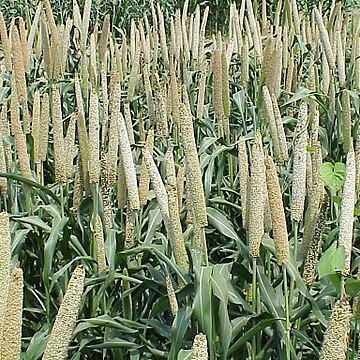Tufted annual 2 000-3 000 mm high. Leaf blade 300-1 000 x 20-70 mm, flat; ligule a fringe of hairs. Inflorescence a false spike 200-500 x 30 mm, subglobose to linear; rachis cylindrical, hairy; involucre encloses a spikelet cluster of 1-9 spikelets on a hairy basal stipe 1-25 mm long; involucral bristles many, shorter to as long as spikelets, inner bristles plumose or glabrous. Spikelet 3-7 x 5 mm; glumes 2.5-3.2 mm long, similar, membranous, pubescent at apex; lower floret male or sterile, lemma margins usually hairy, lower palea present, pilose between keels; upper lemma dissimilar to lower, smooth, hard and shiny, usually densely pubescent on margins; anthers 2.2-2.5 mm long, apex with a tuft of hairs.
A millet grass. It is an annual grass. It grows to 3 m tall. The leaf blades are 20-100 cm long by 2-5 cm wide. The flower is dense and 40-50 cm long by 1.2-1.5 cm wide. They also vary a lot in shape and size. Plants that tiller produce smaller heads. The species varies a lot. There are 13 cultivated, 15 weed and 6 wild races of this grass. It has a cylindrical ear like a bullrush. The grains are small and round and have a shiny grey colour like pearls. There are thousands of cultivated varieties.
Annual, tufted, up to 3 m high. Leaf blades 300-500 mm long, 20-50 mm wide. Spikelets ± 7 mm long, 5 mm wide. Inflorescence a false spike 200-500 mm long, 30 mm wide; each spikelet cluster on a hairy stalk ± 5 mm long; involucral bristles shorter to as long as spikelets, only inner bristles plumose.
Panicle 4 cm.–2 m. long, subglobose to linear; rhachis cylindrical, villous; involucre persistent, borne upon a stipe 1–25 mm. long, enclosing 1–9 spikelets; bristles glabrous or plumose.
Both lemmas usually pubescent on the margins.
Leaf laminae up to 1 m. long and 7 cm. wide.
Culms stout, up to 3 m. high.
Spikelets 3–6 mm. long.

